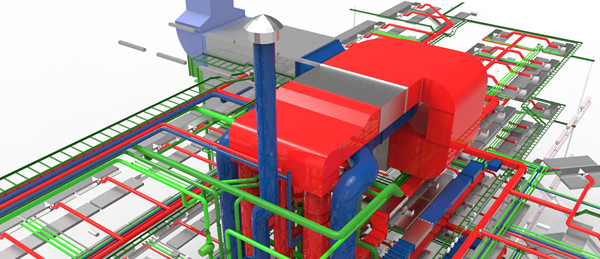Planning and thinking in BIM - "A unique selling point"

tab: Mr. Walser, the release of DDS-CAD 10 is imminent - what can the users expect?
Rainer Walser: At Light + Building we have presented the new features of DDS-CAD 10 for the first time. The extended and automatic component position detection has received very enthousiastic feedback. DDS-CAD now automatically recognizes all different situations on the back side of a wall or surface - horizontal and vertical - and takes these situations into account for the heat load calculation according to EN 12831. This is a unique selling point. On a horizontal plane, such a function is perceived as standard by the market. However, adjacent situations are also detected across storeys, like for example for stairwells. For bigger projects and complex architecture with split levels, it provides an immense time-saver, especially when one considers the revision processes. We instantly obtain very precise heat load calculation results - without time consuming manual workarounds. One of our customers indicated that he saved 75% of his time working with this function on his latest project.
tab: What consequences does this have for the further planning process?
Rainer Walser: The calculated heat load is directly related to the automatic dimensioning and placement of radiators, underfloor heating and pipe sizing. The users only needs to select the product type from the product database and reuse the information contained in the BIM model to define the positioning, such as dependencies on windows, etc. The design, dimensioning and placement is done automatically. However, this does not prevent the user of making individual and manual adjustments. Also thermal bridges can be taken into consideration. The more exact the heat load calculation, the more efficient the material, equipment and energy supply of the building. Just think of the requirements of passive and plus-energy buildings and of course for larger industrial plants. Their efficient operation must begin at the first planning steps.

tab: How far do the functionalities for planning heating systems reach in DDS-CAD?
Rainer Walser: The entire pipe network design is flexible, allowing changes at any time. The DDS-CAD user has unlimited possibilities: he can switch from 2D to 3D and vice versa. Single line, 2D and 3D views are available to represent the same objects and systems in different ways for different purposes. Users can design pipes directly in 3D view and assess the size and distance to each other very well. Calculations are possible at any time, the pipe dimensions will be adjusted automatically.
For calculating heating systems, DDS-CAD first determines the volume flow, which is required by the end consumers in the system, and then dimensions the diameter of the pipes accordingly. The user can consider a maximum flow rate of the heating medium and a fixed pressure drop. In the calculation dialog the flow rates, velocities and pressure losses are directly visible for each sub-segment, including calculated settings for valves, pumps and boilers. The pipe systems can be documented as installation plans, line and system diagrams.
tab: a political objective is to construct buildings or to renovate them so that they provide more energy in the course of a year than they need. What potential offers DDS-CAD in this perspective?
Rainer Walser: The exceptionally good energy balance of today's new buildings is primarily due to an extremely tight building envelope. Due to this, residential constructions need to provide mathematical proof for protection against moisture. For this to be achieved, the calculated minimum air exchange rate cannot be realized by "fresh air" ventilation. As a result, other technical measures have to be taken to meet the requirements of suchs standards.
For this purpose, DDS-CAD provides planning and calculation features for controlled (residential) and larger industrial mechanical ventilation systems and full climate control systems, which can be automatically taken into consideration in the heat load calculation.
The air exchange rate is automatically divided among the individual air passages and is used simultaneously as thermal information for the heat load calculation by defining a supply air temperature. Values that are required for many different calculations have to be entered only once. This enhances the speed, efficiency and avoids data redundancy and errors. The ventilation system is a key element for building services. PV, solar thermal and KNX building automation are becomming more important as well. With solutions for mechanical, electrical and plumbing, as well as PV and lightning protection, DDS-CAD provides a flexible set of tools for multi-disciplinary project planning. For planning PV systems, the self-consumption profiles have been extended in DDS-CAD 10, in order to achieve a better comparison between yield and power consumption.
In bigger projects, the planning and coordination of all disciplines is facilitated by the active real-time collision prevention functionalities. During the routing of systems it is possible to bypass existing objects and prevent a collision automatically. To make use of this functionality not all modules of DDS-CAD have to be installed on the user's workstation. For a collision check it suffices to ghost the other disciplines in the active model.

tab: how is the topic Building Information Modeling (BIM) thereby integrated, which is likely to gain more importance in the future?
Rainer Walser: BIM is the key to cooperation in the construction industry for us. It is about the ability to freely communicate between software systems, so we speak of OpenBIM. DDS-CAD is a fully integrated OpenBIM platform, for which the core idea from the beginning of its developement was focused on a BIM solution, providing the ability to use "smart" data in a 3D building model. The industry is still largely determined by vendor-specific solutions. Proprietary formats will always remain, but limited. We must get away from this selfishness and focus on the planning efficiency instead. If everyone involved in a project can access the data from the same basic model, because it is available in an interchangeable format, we will achieve a huge gain in time and efficiency.
The current efforts of post editing of DWG and PDF plans would not be necessary any longer, together with the corresponding source of errors and mistakes. To facilitate such an open communication in the construction industry, a common language is required and that is the IFC format (Industry Foundation Classes), developed by buildingSMART. I tend to compare IFC with html; we can still open a website that was created in the early 90s without having to use a browser from that time. For over ten years we are investing in the independent information exchange via IFC, as a result, DDS-CAD is officially certified by buildingSMART. Together with other software vendors that follow the same philosophy, such as Graphisoft, Tekla and Nemetschek Allplan, we have teamed up in the OpenBIM alliance to also establish the processes and methods in German-speaking countries, as is already the case in the international market.
The prefix "Open" is crucial, because it is about the willingness to exchange information in the first place. Therefore "Open" is not exclusively associated with IFC, but also gbXML, Cobie, BCF and generally all direct interfaces between different platforms. Another advantage of OpenBIM is that the data can be used throughout the entire lifecycle of a building. In the planning phase, it ensures efficient exchange and cross-discipline coordination. But also as input for facility management, planning, cost estimating and for later renovations.

tab: What consequences would a functioning system independent information exchange have?
Rainer Walser: Users can work with the tools that fit their requirements and processes in the best possible way, and not use less suitable ones due to compatibility reasons. DDS-CAD is a powerful tool for MEP and BIM modeling and provides many features, but no software in the world will be able to cover all requirements imposed on the planner in the construction process, at least not within a foreseeable future.
Original German publication can be found here on the tab website.
